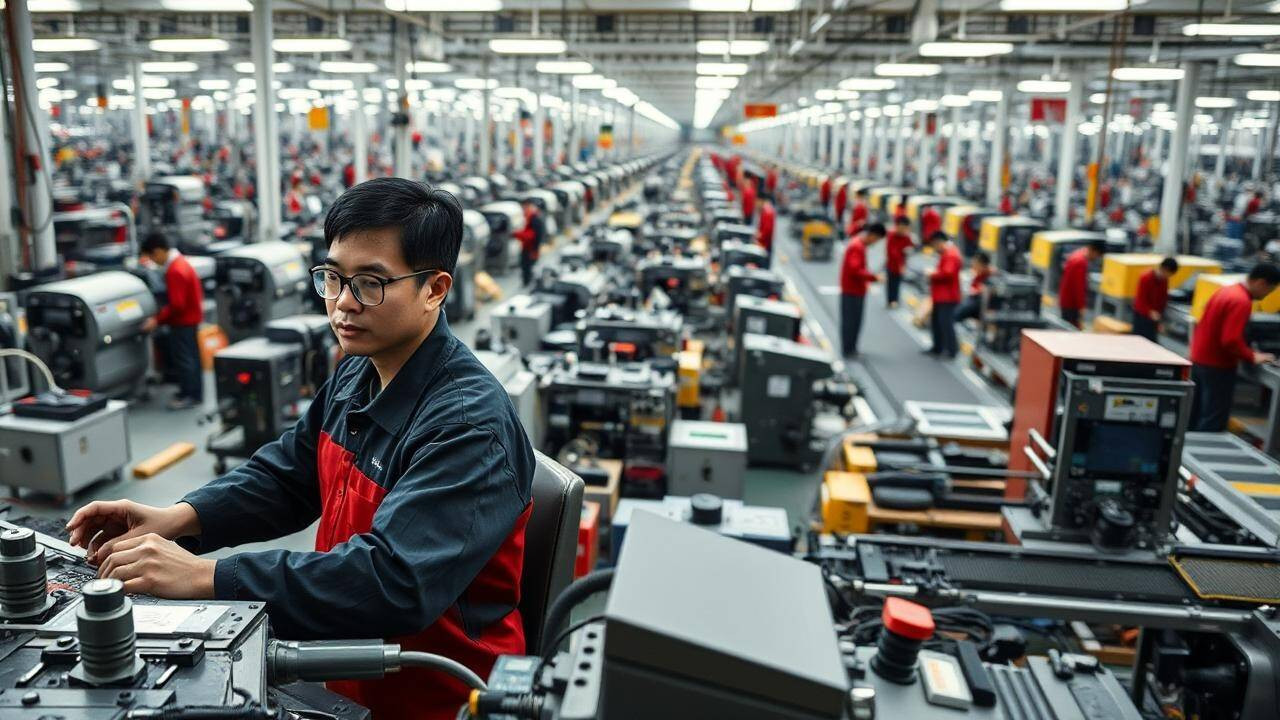China’s industrial production saw a slight uptick in August, though still contracting for the fifth month, amidst ongoing trade talks with the U.S. The Purchasing Managers’ Index edged up to 49.4, signaling a minor improvement despite broader economic challenges like property debt and youth unemployment.
Is China’s Economy Showing Cracks? Factory Output Slides Again
The world’s second-largest economy is facing headwinds, and the latest data from China paints a picture that’s anything but rosy. For the fifth consecutive month, factory output has contracted, raising concerns about the overall health of the Chinese economic engine. The Caixin China General Manufacturing Purchasing Managers’ Index (PMI), a key indicator of manufacturing activity, landed at 49.4 in August. Any reading below 50 signifies a contraction. So, what’s behind this persistent slump, and what could it mean for the global economy?

One major factor is the ongoing trade tensions with the United States. The protracted negotiations, marked by tariffs and counter-tariffs, have undoubtedly dampened business sentiment and disrupted supply chains. Many Chinese manufacturers, reliant on exports to the US, are feeling the pinch. The uncertainty surrounding the trade war makes it difficult for businesses to plan and invest, leading to a slowdown in production. These trade wars are not just numbers on a spreadsheet; they represent real challenges for companies and workers across China.
But the trade war isn’t the whole story. Domestic demand within China appears to be softening as well. The real estate sector, long a driver of economic growth, is facing challenges. This has a ripple effect on industries like construction, steel, and home appliances, all of which are heavily reliant on a strong property market. A sluggish real estate market impacts consumer confidence. People are less likely to spend on big-ticket items when they worry about the value of their homes or the overall economic outlook.
Why Factory Output Matters
Factory output is a critical gauge of a country’s economic health for several reasons. Firstly, it’s a direct measure of industrial activity, providing insights into production levels, employment, and investment. Secondly, it impacts international trade. China’s role as the “world’s factory” means that its manufacturing output influences global supply chains and prices. When Chinese factories slow down, it can lead to shortages and higher prices for goods worldwide.
What strategies might the Chinese government employ to reverse the contraction in factory output?
Government Intervention: Can it turn the tide?
The Chinese government is acutely aware of the challenges facing its economy and has already taken steps to stimulate growth. These measures include targeted tax cuts, infrastructure spending, and easing of monetary policy. The government hopes these policies will boost domestic demand and encourage investment.
However, the effectiveness of these measures is debated. Some argue that the government’s interventions are too little, too late. Others worry that excessive stimulus could lead to inflation and other economic imbalances. The Chinese government needs to carefully balance the need for short-term growth with the long-term sustainability of its economy. For more insights into economic policy, consider reading our article on [fiscal stimulus packages](link-to-relevant-article-on-your-site).
The Global Implications of China’s Economic Slowdown
China’s economic performance has profound implications for the global economy. As a major importer of raw materials and a significant consumer of goods and services, a slowdown in China can ripple through the world economy, affecting commodity prices, trade flows, and investment decisions.
Countries that rely heavily on exports to China, such as Australia (natural resources) and Germany (automobiles), are particularly vulnerable. A weaker Chinese economy can translate into lower demand for their products, impacting their own economic growth. The global financial markets are also watching closely. Investors are wary of the potential for further economic weakness in China and its impact on global growth.
Navigating the Challenges of China’s Manufacturing PMI
China faces a complex set of challenges, from trade tensions to softening domestic demand. Overcoming these hurdles will require a combination of strategic policy adjustments, effective implementation, and a stable global economic environment. The world is watching to see how China navigates these challenges and whether it can reignite its economic engine. While the current data is concerning, it’s important to remember that China has demonstrated remarkable resilience in the past. Whether it can do so again remains to be seen, but the stakes are undoubtedly high, not just for China, but for the entire global economy.







